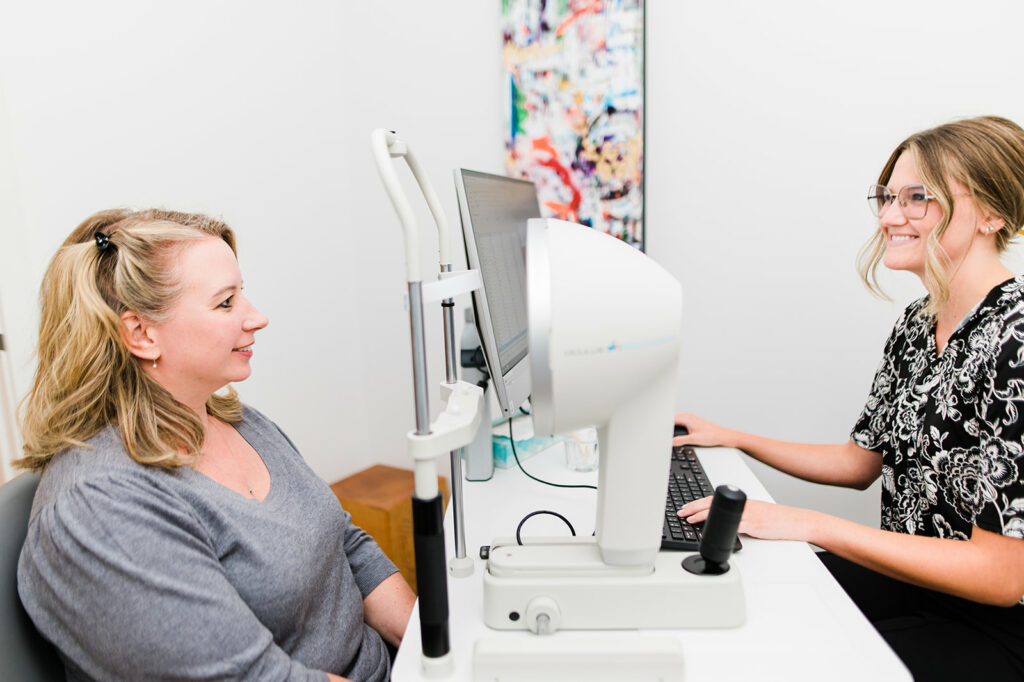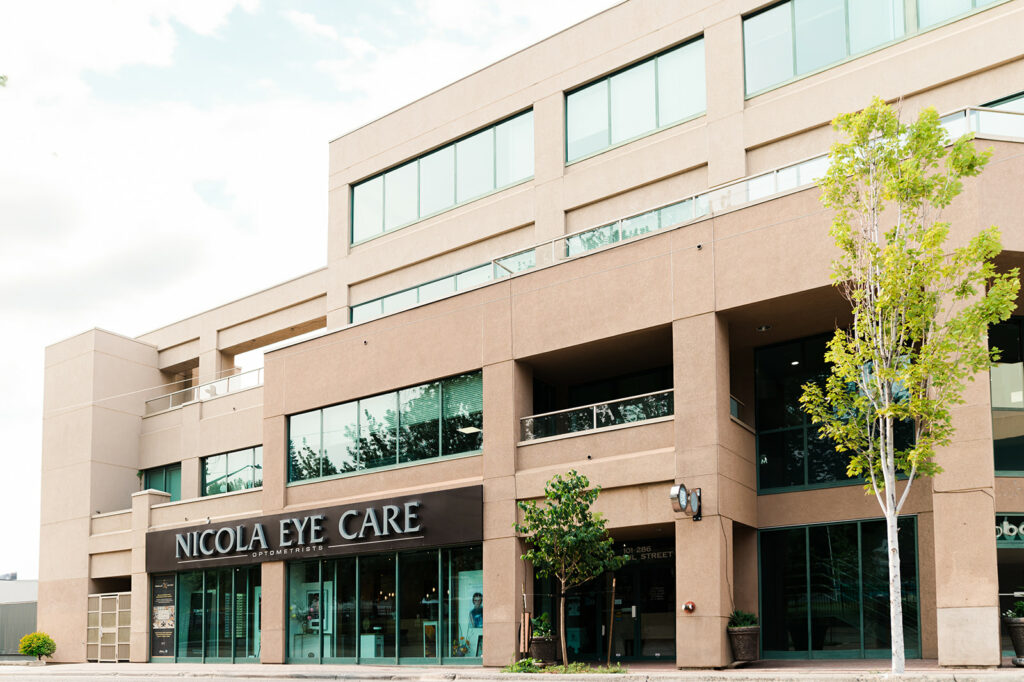Whether you’re actively seeking glaucoma treatment or just looking for more information, it can be overwhelming to navigate the world of glaucoma. Between understanding potential underlying causes, the different types, and the treatment options available to you, there is a lot to learn!
In this post we break down all the need-to-know information so you can explore the latest information available and empower yourself with knowledge on all things glaucoma.
Do you have a question our Kamloops team could support you with? Contact us now.

What is Glaucoma?
Glaucoma describes a group of eye conditions that damage the optic nerve, usually due to increased pressure within the eye. This damage can lead to progressive and irreversible vision loss. It often develops without noticeable signs—-which means your symptoms of glaucoma may be limited or even non-existent—making regular eye exams important for early detection. This condition can affect individuals of all ages, but it is more common in older adults.
What Causes Glaucoma?
The exact cause of glaucoma is not always clear, but there are contributing factors. Here are a few factors that can contribute to the development of glaucoma:
- Increased Intraocular Pressure (IOP): Elevated IOP is the greatest risk factor for glaucoma. It can result from an imbalance between the production and drainage of the aqueous humor (the clear fluid that fills the front of the eye). When the drainage system is less efficient or blocked, the fluid accumulates, causing increased pressure on the optic nerve.
- Genetics: There is evidence to suggest that a family history of glaucoma can increase the risk of developing the condition. Certain genetic factors may play a role in a person’s susceptibility to glaucoma.
- Age: Glaucoma is more common in older individuals. As people age, their risk of developing glaucoma increases.
- Ethnicity: Some ethnic groups, such as African Americans and Hispanics, are at a higher risk of developing certain types of glaucoma, like primary open-angle glaucoma.
- Eye structure: The anatomy of the eye can contribute to glaucoma risk. For instance, a shallow anterior chamber angle may increase the risk of angle-closure glaucoma.
- Medications and medical conditions: Some medications, such as corticosteroids (when used for extended periods), can increase IOP and potentially lead to glaucoma. Certain medical conditions, such as cardiovascular disease, can be associated with an increased risk of glaucoma.
- Eye injury or trauma: Past eye injuries or trauma can sometimes lead to glaucoma, especially if they disrupt the eye’s drainage system.

Testing for Glaucoma
Are you wondering if you might have this condition? Glaucoma is typically diagnosed through a series of eye examinations. The key components of glaucoma testing include measuring intraocular pressure, assessing the optic nerve, and evaluating the visual field.
There are different types of glaucoma, with the two main types being open-angle glaucoma (slow progression) and angle-closure glaucoma (sudden increase in pressure).
Open-Angle Glaucoma. This is the most common form of glaucoma. In open-angle glaucoma, the drainage angle within the eye becomes less efficient at allowing fluid (aqueous humor) to flow out of the eye. As a result, fluid accumulates, causing an increase in intraocular pressure. Over time, elevated pressure damages the optic nerve fibers, leading to vision loss. Open-angle glaucoma typically progresses slowly and often goes unnoticed until significant damage has occurred.
Angle-Closure Glaucoma. This type of glaucoma occurs when the drainage angle between the cornea and the iris becomes blocked, causing a sudden increase in intraocular pressure. Angle-closure glaucoma can lead to rapid and severe symptoms, including eye pain, headache, nausea, vomiting, and blurred vision. This is considered a medical emergency and requires immediate treatment to relieve the pressure and prevent permanent vision loss.

Glaucoma Treatment Options
When it comes to glaucoma treatment, your eye health professionals can employ the tools available at their disposal to keep you comfortable and preserve your vision as much as possible.
Glaucoma treatment involves reducing intraocular pressure through various means including medications, laser therapy, or surgery to prevent further vision loss. Your best option or options will depend on your individual circumstances. Here’s a little more information about these options:
Medications for glaucoma.
Medications are often the first line of treatment for glaucoma, and these come in the form of prescription eye drops. There are several classes of medications used to treat glaucoma including beta-blockers, alpha agonists, rho kinase inhibitors, and more. These medications may be prescribed on their own or as a combination of two different classes of glaucoma medications to improve their effectiveness.
Laser surgery for glaucoma.
This is considered a minimally invasive option and is typically performed in an outpatient setting. It may be used as a primary treatment or in conjunction with other medications or surgical procedures, depending on the severity and type of glaucoma. The choice of laser surgery and the specific technique used will be based on the patient’s individual condition and response to treatment.
Surgery for glaucoma.
Surgery is sometimes necessary to manage glaucoma when other treatments, such as medications and laser therapy, are insufficient in controlling intraocular pressure or when the condition is progressing despite treatment. Glaucoma surgery aims to create alternative pathways for aqueous humor drainage from the eye, reducing IOP and preventing further damage to the optic nerve.

How is Glaucoma Treated?
Optometrists and ophthalmologists often work together to co-manage patients with glaucoma, ensuring comprehensive and effective care.
Remember that both ophthalmologists and optometrists play crucial roles in your eye health. Ophthalmologists specialize in treating specific eye conditions like glaucoma, but your optometrist provides foundational care such as routine eye exams, early detection of issues, and more—which are especially important when you have an eye condition like glaucoma. Regular visits to both doctors ensures comprehensive and well-rounded care for your eyes.
Here’s how this collaboration for management of glaucoma typically works:
Optometrist: Conducts routine eye exams and may identify signs of glaucoma during comprehensive eye assessments. If glaucoma is suspected, the optometrist initiates diagnostic tests such as tonometry, visual field testing, and optic nerve assessments. Our optometrists develop a treatment and monitoring plan based on your condition and provide education to leave you with an empowered understanding of your options.
Ophthalmologist: The ophthalmologist may be consulted for confirmation of diagnosis and more specialized testing if necessary. They can also offer further insight into treatment options, especially in cases where advanced interventions are needed.
Your ophthalmologist can also provide guidance on potential surgical interventions if the disease progresses. For example, some surgical procedures require additional measures like laser trabeculoplasty or drainage implant surgery.
Overall, the collaboration between optometrists and ophthalmologists allows you, the patient, to receive well-rounded care that combines expertise from both professionals. This team-based approach ensures that patients have access to a range of treatments and interventions, leading to more effective glaucoma management and maximum preservation of your vision.
If I see an ophthalmologist, do I need regular exams with my optometrist too?
The short answer: Yes! Even if you are seeing an ophthalmologist for glaucoma management, regular visits to an optometrist are still important for comprehensive eye care.
Here’s why: Optometrists are trained to provide comprehensive eye care beyond specific conditions like glaucoma. They can assess your overall eye health, screen for other eye conditions (such as cataracts, diabetic retinopathy, and macular degeneration), and detect any changes that might not be related to glaucoma.
Imagine going to a cardiologist for your heart, and never returning to your family doctor for regular check-ups for the rest of your health and wellness! That’s what seeing an ophthalmologist without following up with your optometrist regularly is like.
While ophthalmologists primarily focus on treating complex eye conditions, one of which is glaucoma, optometrists can help monitor your overall eye health and the effectiveness of your glaucoma treatment over time.
Optometrists are also the ones that will provide updated glasses prescriptions to ensure you have the correct vision correction and offer guidance on preventive measures to protect your eyes, such as advice on UV protection, eye safety, and maintaining good eye hygiene.

Come See Us for Glaucoma Treatment
Glaucoma treatment is crucial for those with this condition, and testing regularly is the best way to ensure early detection and management. Don’t wait to take the steps that will help you maintain your overall eye health long term! Come See Us for detection, assessment, and glaucoma treatment and preserve your overall eye health. We look forward to seeing you.